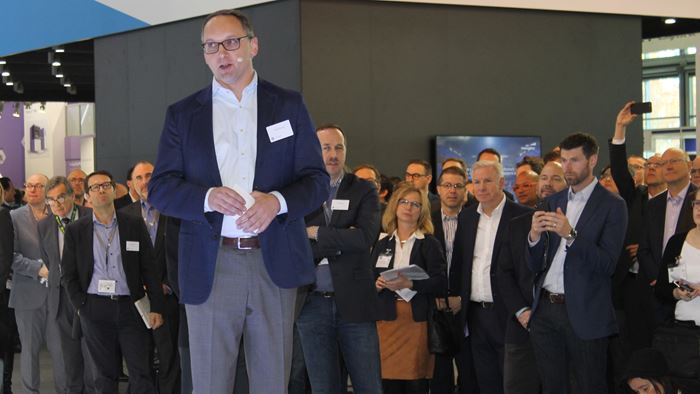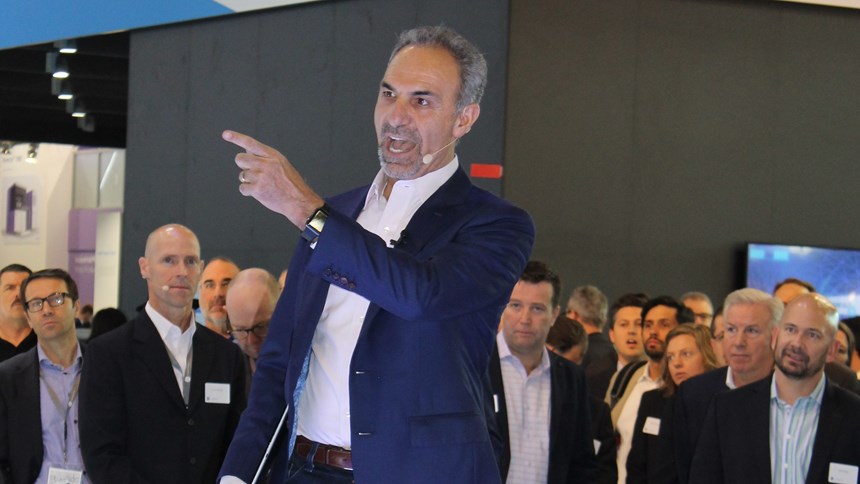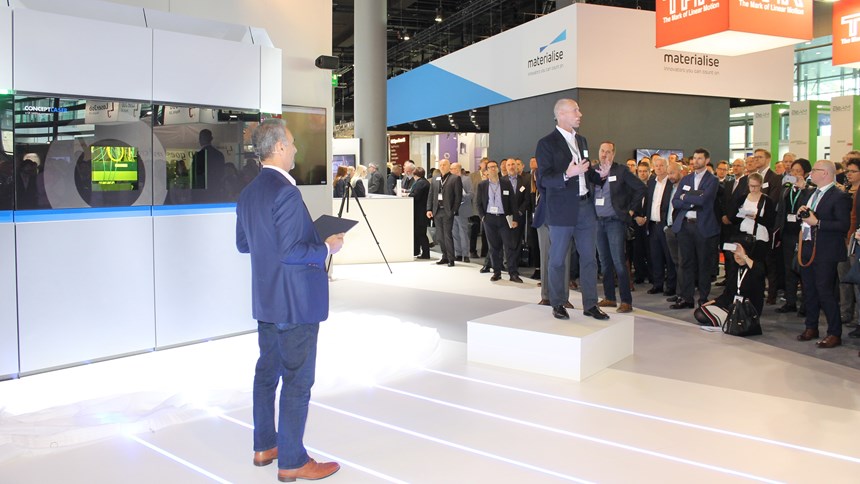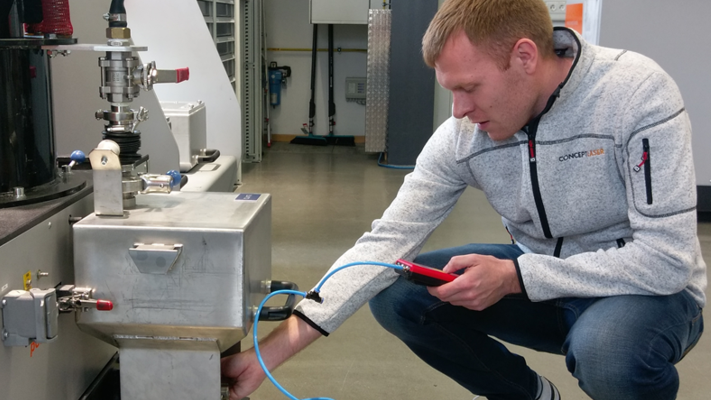GE and Concept Laser Aim to Lead Digital Transformation of Industrial Production
European correspondent Barbara Schulz spoke to Concept Laser founder Frank Herzog to find out how the dynamic between the German company and U.S.-based GE forms the perfect symbiosis to grow a global AM business.
When GE Additive's Vice President, General Manager, Mohammad Ehteshami lowered the curtain on the first GE Additive-branded machinery to the gathered crowds at Formnext 2017 in Frankfurt, Germany, the machine called A.T.L.A.S (ATLAS; Additive Technology Large Area System), developed by teams at GE Additive and Concept Laser, reflected the enormous growth path the two companies have been jointly following since GE acquired a 75 percent stake in the Lichtenfels, Germany-based company in 2016.
The beta machine on the show floor, a laser-powered 3D printer that prints parts from metal powder, has a build volume of 1.1 by 1.1 by 0.3 meters, with the Z axis scalable to beyond 1 meter.
Frank Herzog, founder and CEO of Concept Laser said that this kind of project is precisely the reason Concept Laser was so keen to team up with GE Additive. “When I first came to Messe Frankfurt (Euromold) armed with a metal AM machine in 2001 I never expected to be where I am today,” he says.
Herzog joined his wife’s uncle’s company Robert Hofmann in the mid-1990s, where he was working in the prototyping shop. The shop included one of Germany’s first stereolithography machines, which printed 3D models from successive layers of resin and solidified them with ultraviolet light. Herzog believed that if he replaced the UV light in the stereolithography machine with a laser beam, he would be able to print parts from metals. And he did.
Herzog and his wife incorporated Concept Laser in 2000, took up a small space in Robert’s factory and started assembling their first machine. When they brought it to the Euromold trade show in Frankfurt the next year, it was the first laser-powered, metal-melting 3D printer on the market, and the growth in the 17-year period since then has been nothing short of phenomenal.
Since the GE acquisition, Concept Laser has grown from 200 to 400 employees, tripled its machine output, and broke ground on a new Lichtenfels facility to house more than 700 people. “GE shares our vision regarding the potential for additive manufacturing to lead the digital transformation of industrial production,” Herzog says.
Listen to Your Customers
But for Herzog the acquisition doesn’t mean he exclusively delivers his machines to GE. “For every machine delivered to GE a further three are delivered to the market,” he says. “GE Aviation is a great customer, and the demands from the aerospace industry on end-use 3D-printed parts are high. But there is a huge market for our machines, there are new applications not only in aerospace but also medical, moldmaking and many other industries. What applied to our small business when we started the company 17 years ago is still true today: You grow with your customers if you are interested in what they do, if you listen to them, if you take them seriously and jointly develop new applications and solutions.”
Airbus and Laser Zentrum Nord, for instance, used a Concept Laser printer to design and print a “bionic” wing bracket for Airbus’ latest A350 XWB passenger jet and make it 30 percent lighter, a feat that earned Herzog and two of his colleagues Airbus the prestigious German federal president’s prize in 2015. Today, Concept Laser’s M lab machine can print precise hip joint replacements and surgical tools. The company’s giant X Line 2000R machine can make entire engine blocks. In 2016, the company sold more than 150 units, and around 750 Concept Laser machines are in service worldwide. With GE Additive, these numbers will grow even faster.
Herzog is excited and very pleased to have a partner like GE, because the company has a similar vision and knows that products have to be brought to market quickly to be tested by real customers, not just by universities and laboratories. “Products have to prove themselves in the market, they have to be evolved together with your customers, and GE knows that time-to-market is crucial in our business,” Herzog says.
The ATLAS AM system is a good example, Herzog explained. “Nine months ago we told our team that we have a tight deadline and installed a countdown-counter in our R&D facility. Many team members thought it’s not possible to develop a huge machine like ATLAS in such a short period of time. But exactly 12 hours before the deadline the machine was ready for its first text run. Today, there are several beta machines running at our customers’ sites, which is important because we get essential feedback which is fed back to our product development department.”
When Concept Laser started to rapidly grow and nearly doubled in size every year, Herzog knew it was time to look for a partner to manage this rapid growth rate. Among the 48 companies interested in a partnership with Concept Laser was GE Additive, and Herzog said he never looked back once the deal was sealed in late 2016.
“GE’s management team did not only bring a business model to the table, but also enthusiasm and passion for our technology,” Herzog explains. “GE’s culture is similar to ours, people are down-to-earth and thoughtful. We are not regarded as a company to be integrated into the GE Group, we rather form a kind of start-up company together with GE Additive. In fact, working with an American company offers many advantages. German and American cultures form a perfect symbiosis.”
German Engineering Meets American Can-Do Attitude
The partnership between GE and Concept Laser is a great opportunity for both companies because German engineering know-how and the so-called American “can-do attitude” complement each other, Herzog says. “We have the chance to mix these two cultures. While Americans are not afraid to think outside the box, to get up again when they fall, the German engineer is afraid to fall because getting up is so very difficult. Once your reputation is ruined that’s it. That’s what I find different in the United States. While our engineers keep developing a product until it’s perfect (but might not enter the market for many years), the U.S.-engineer says let’s take the product to market, try it and gain experience. That’s important in my opinion. And what could be better than a combination of these two cultures?”
Not much one might think. One year after GE acquired the 75 percent stake in Concept Laser, the companies laid the foundation for a new facility in Lichtenfels on November 30, 2017. In the future, the 3D Campus will unite research and development along with production, service and logistics. The new offices should be ready for move-in early 2019, and around 40,000 square meters will provide room for about 500 employees. The future machine production capacity will be four times higher than today. This will make Concept Laser’s Lichtenfels facility a global GE center for the production of metal 3D printing machines, the companies say. About 105 million euros will be invested into the location.
“We are not only laying the foundation for a new facility, but also creating skilled jobs in the region. Lichtenfels will become a global beacon for industrial 3D printing as the new GE center,” Herzog says.
Since skills are the essential ingredient for any successful business, GE and Concept Laser have 450 machines in use worldwide for education and training, and Concept Laser’s Academy trains students to become expert engineers in additive manufacturing. What started with two students writing their engineering thesis at Concept Laser in 2007 has turned into the “Concept Academy,” where students are trained in-house to accommodate growth and the increasing demand for skilled engineers; someone has to build the machines if GE Additive will really be on track to fulfill Ehteshami's Formnext 2016 promise to deliver 10,000 machines in the next ten years.
Related Content
Machine Tool Drawbar Made With Additive Manufacturing Saves DMG MORI 90% Lead Time and 67% CO2 Emission
A new production process for the multimetal drawbar replaces an outsourced plating step with directed energy deposition, performing this DED along with roughing, finishing and grinding on a single machine.
Read MoreThis Drone Bird with 3D Printed Parts Mimics a Peregrine Falcon: The Cool Parts Show #66
The Drone Bird Company has developed aircraft that mimic birds of prey to scare off problem birds. The drones feature 3D printed fuselages made by Parts on Demand from ALM materials.
Read More3D Printed Titanium Replaces Aluminum for Unmanned Aircraft Wing Splice: The Cool Parts Show #72
Rapid Plasma Deposition produces the near-net-shape preform for a newly designed wing splice for remotely piloted aircraft from General Atomics. The Cool Parts Show visits Norsk Titanium, where this part is made.
Read MoreDMG MORI: Build Plate “Pucks” Cut Postprocessing Time by 80%
For spinal implants and other small 3D printed parts made through laser powder bed fusion, separate clampable units resting within the build plate provide for easy transfer to a CNC lathe.
Read MoreRead Next
Profilometry-Based Indentation Plastometry (PIP) as an Alternative to Standard Tensile Testing
UK-based Plastometrex offers a benchtop testing device utilizing PIP to quickly and easily analyze the yield strength, tensile strength and uniform elongation of samples and even printed parts. The solution is particularly useful for additive manufacturing.
Read MorePostprocessing Steps and Costs for Metal 3D Printing
When your metal part is done 3D printing, you just pull it out of the machine and start using it, right? Not exactly.
Read More3D Printed Polymer EOAT Increases Safety of Cobots
Contract manufacturer Anubis 3D applies polymer 3D printing processes to manufacture cobot tooling that is lightweight, smooth and safer for human interaction.
Read More

























